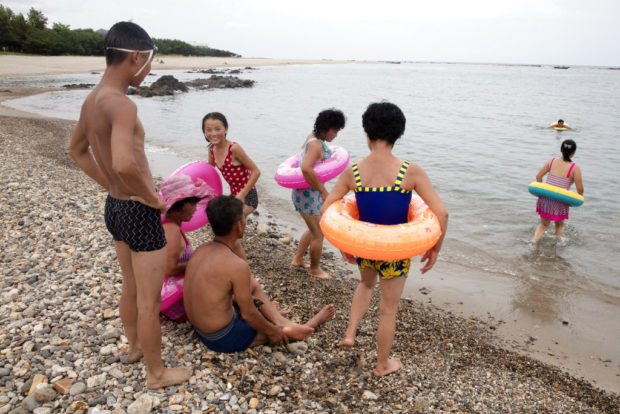
In this Aug. 20, 2018 photo, North Koreans enjoy the day on a seashore near Mount Chilbo, North Korea. Mount Chilbo, one of the country’s most cherished natural attractions, is gearing up for a future it hopes will include a lot of economic development. AP
MOUNT CHILBO, North Korea — Tanned and wearing a swimsuit, So Myong Il walks to the barbecue pit and throws on some clams.
He obviously loves the beach he’s on as well as the rugged, emerald Chilbo mountains that rise abruptly behind it.
He loves them enough to forget, for a moment at least, that he is a senior official sent to deliver an ideology-soaked pitch singing their praises and instead lets the natural beauty surrounding him speak for itself.
Comrade So sees great things for North Korean attractions like this.
Hotels, big and small. Tourists from all over the country, maybe the world. “As long as we have the leadership of our respected Marshal,” he says, referring to leader Kim Jong Un, “our future will be bright indeed.”
So wouldn’t think of questioning the leader, but there is a hint of apprehension in his voice. And he isn’t alone.
North Korea is pushing ahead with a new strategy of economic development and the intensified diplomacy with China, South Korea and the United States that such a move requires. But hopes for a better future are mixed with concern over potential downsides of political or social volatility, and something that’s harder to articulate: a fear of the unknown — even if it appears far more promising than the arduous path the country has been on for decades.
Even before announcing in January that he had sufficiently perfected his nuclear arsenal and could start to focus on other things, Kim has held economic development to be his primary long-term concern.
He has allowed markets and entrepreneurialism to flourish and, since succeeding his father as leader seven years ago, has dramatically transformed the skyline of the capital, Pyongyang, with several high-rise districts. The transformation in the east coast city of Wonsan, where Kim has a summer villa, has been almost as spectacular.
As Kim prepares for the 70th anniversary of North Korea’s founding on Sept. 9, his ambitious development plan is being implemented, from the small-time renovation of town halls to the almost biblical-scale mobilization of “soldier-builders,” who are working around the clock to turn the remote northern city of Samjiyon into yet another showcase of Pyongyang-style socialism.
Economic development — and how US capital and know-how could speed it along — was President Donald Trump’s big carrot when he met with Kim in Singapore three months ago to try to negotiate a denuclearization deal.
But Kim’s diplomatic overtures aren’t intended to open the door to American capitalists, a scenario that would make any good party cadre shudder. They are aimed at breaking down support for sanctions and getting the US to step out of the way. Kim’s game is to play China and the US off each other, grab whatever concessions he can along the way and adjust his position as the situation evolves.
In the meantime, lest anyone get the wrong idea, the ruling Workers’ Party of Korea has begun churning out paeans to socialism in its daily newspaper along with anti-capitalism, anti-imperialism screeds that underscore North Korea’s official opposition to essentially anything that might be considered the American way of life. Or, as it’s known in the jargon of North Korea’s propaganda machine, “the imperialists’ bourgeois ideological and cultural poisoning.” /ee

